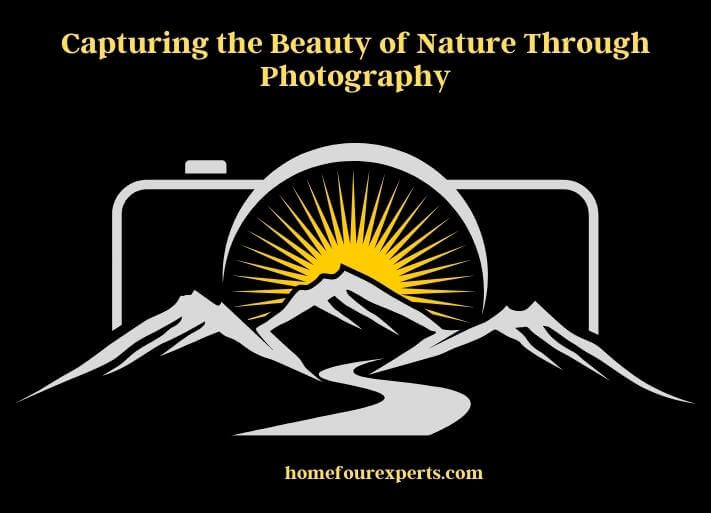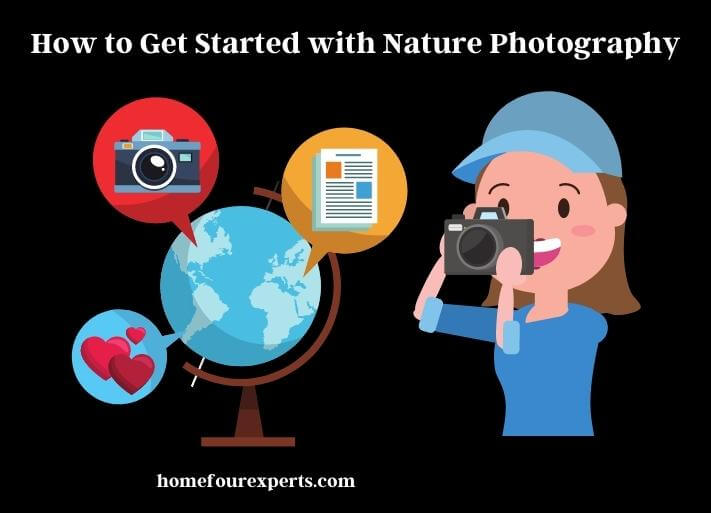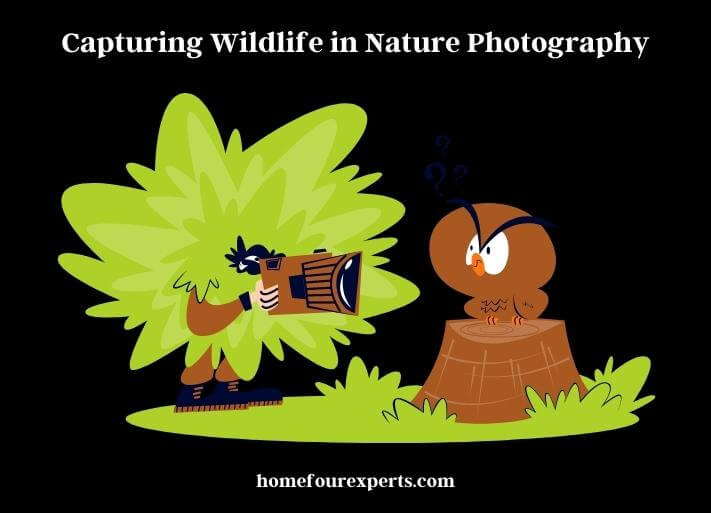Capturing the beauty of nature through photography is a deeply rewarding experience that allows us to connect with the world around us in a meaningful way. Nature photography has the power to transport us to far-off places, capture fleeting moments of beauty, and inspire us to see the world in new and exciting ways. It’s an art form that requires patience, skill, and a deep appreciation for the natural world.

We will delve into the world of nature photography, exploring the techniques and tools used by professional photographers to create stunning images of the natural world. Whether you’re a seasoned pro or just starting out, this article will provide you with valuable insights and practical tips for taking your nature photography to the next level. So sit back, grab your camera, and let’s explore the beauty of nature through the lens of photography.
How to Get Started with Nature Photography?
Getting started with nature photography can be an exciting and rewarding journey. Whether you’re looking to capture stunning landscapes, breathtaking wildlife, or intricate details of the natural world, there are a few key steps you can take to get started.
- While it’s possible to take great nature photos with just a smartphone camera, investing in a quality camera and lens will give you more control over your images and allow you to capture more detail and depth. Look for a camera with manual controls, a fast shutter speed, and the ability to shoot in RAW format. A telephoto lens is also essential for capturing wildlife and distant landscapes.
- To capture the beauty of nature, it’s important to understand your subject. Whether you’re photographing a mountain range or a delicate flower, take the time to study the details and characteristics of your subject. This will help you determine the best lighting, angle, and composition for your shot.
- Before heading out to photograph nature, scout your location and plan your shots. This will help you determine the best time of day to shoot, as well as the best vantage points for capturing your subject. Check the weather forecast and consider how different lighting conditions will affect your shots.
- Nature photography requires patience and persistence. Sometimes, you may need to wait for hours or even days to capture the perfect shot. But with patience and a bit of luck, you’ll be rewarded with stunning images that capture the beauty of the natural world.
- Composition is a key element of nature photography. Experiment with different angles, framing, and perspectives to create interesting and dynamic shots. Use leading lines to draw the viewer’s eye into the image, and consider the rule of thirds to create a balanced composition.

The Role of Light in Nature Photography
Light is one of the most important elements in nature photography. It has the power to transform an ordinary scene into a breathtaking image, evoking emotion and capturing the beauty of the natural world.
Light illuminates your subject, revealing its details and bringing it to life. The angle and direction of the light can create shadows and highlights that add depth and dimension to your image. The color of the light also affects the mood and atmosphere of your photo. Warm, golden light at sunrise or sunset can create a sense of warmth and intimacy, while the cool, blue light on a cloudy day can create a moody, atmospheric effect.
Contrast is the difference between the lightest and darkest parts of an image. A high-contrast image can create a sense of drama and intensity, while a low-contrast image can be soft and subtle. Light is the key factor in creating contrast in your images, as it determines the brightness and darkness of different areas of your subject.
Light can bring out the texture and detail in your subject, creating a sense of depth and dimensionality. Shadows can reveal the contours and shapes of your subject, while highlights can bring out intricate details and patterns.
The quality of light can greatly affect the mood and atmosphere of your image. Soft, diffused light on a foggy morning can create a dreamy, ethereal effect, while harsh, direct sunlight can create a sense of heat and intensity.
As a nature photographer, it’s important to understand the role of light and how to use it to your advantage. Experiment with different lighting conditions and angles, and pay attention to the quality, color, and direction of the light. By mastering the art of lighting in nature photography, you’ll be able to capture stunning images that capture the true beauty of the natural world.
Composition in Nature Photography
Composition is the arrangement of elements within a photograph to create a visually appealing and compelling image. In nature photography, the composition is key to capturing the beauty of the natural world and telling a story through your images.
The rule of thirds is a classic composition technique that involves dividing the image into thirds both horizontally and vertically, and placing the subject at one of the intersecting points. This creates a sense of balance and tension in the image, drawing the viewer’s eye to the subject.
Leading lines are lines within the image that guides the viewer’s eye toward the subject. In nature photography, leading lines can be created by the natural contours of the landscape, such as a winding river or a row of trees.
Symmetry and patterns can add a sense of order and harmony to an image. Look for natural patterns in the landscape, such as the repeating shapes of waves on a beach or the branches of a tree.
Creating a sense of depth and layering in your image can add a sense of dimension and complexity. This can be achieved by incorporating foreground elements, such as a rock or a flower, to create a sense of depth and layering within the image.
Negative space refers to the area around the subject in the image. Including negative space can create a sense of balance and breathing room in the image, allowing the subject to stand out and making the overall composition more dynamic.
Capturing Wildlife in Nature Photography
Capturing wildlife in nature photography is a thrilling and rewarding experience, but it can also be challenging. Wildlife is unpredictable, and capturing the perfect shot requires patience, skill, and a bit of luck. Here are some tips for capturing stunning wildlife images in nature photography:

- Before heading out to photograph wildlife, do your research on the species you’re interested in capturing. Learn about their behavior, habitats, and patterns. This will help you anticipate their movements and increase your chances of getting the perfect shot. Also, make sure you have the right gear, such as a telephoto lens, to capture the wildlife from a safe distance without disturbing them.
- Wildlife photography requires patience and observation. Spend time in the field, observing the behavior of the animals you want to photograph. Look for patterns and habits, and anticipate their movements. Be patient and wait for the right moment to capture the shot.
- When photographing wildlife, natural light is your best friend. Avoid using flash or artificial lighting, as it can startle or harm the animals. Instead, use natural light to your advantage, such as shooting during the golden hour or using the sun as a backlight to create a dramatic effect.
- Capturing wildlife in its natural habitat can create a sense of context and tell a story through your images. Include elements of the animal’s environment, such as foliage or landscape, to create a sense of place and give the viewer a better understanding of the animal’s behavior and lifestyle.
- Wildlife photography is not just about capturing the animal, but also the emotion and action at the moment. Look for unique and interesting behaviors or movements, such as a bird taking flight or a lioness protecting her cubs. Capturing emotion and action at the moment can create a more compelling and powerful image.
Landscape Photography in Nature
Landscape photography is a popular genre in nature photography, capturing the beauty and majesty of the natural world. Here are some tips for capturing stunning landscape images in nature photography:

Scout the Location
Before setting up your camera, scout the location to find the best spots for capturing the landscape. Look for interesting features such as rock formations, water bodies, and unique natural elements that can add depth and interest to your images. Consider the weather and time of day to find the best lighting conditions.
Use a Tripod
Using a tripod can help stabilize your camera and ensure sharp images. It also allows you to experiment with different angles and compositions without having to worry about camera shakes. Using a tripod can help you slow down and take the time to carefully compose your shots.
Use a Wide-Angle Lens
Wide-angle lenses are great for capturing expansive landscapes and creating a sense of depth and scale in your images. They allow you to include more of the scene in the frame and emphasize the grandeur of the natural environment.
Use the Rule of Thirds
The rule of thirds is a composition technique that involves dividing the image into thirds both horizontally and vertically, and placing the main elements of the scene along those lines or intersections. This can create a more dynamic and visually pleasing image.
Pay Attention to Light and Color
Light and color play a crucial role in landscape photography. The best time to capture stunning landscape images is during the golden hour, which is the hour after sunrise or before sunset when the light is soft and warm. Pay attention to the colors in the scene and look for complementary or contrasting colors that can add interest and vibrancy to your images.
Experiment with Different Perspectives
Doesn’t be afraid to experiment with different perspectives and angles, such as shooting from a low angle or using a drone to capture aerial views. This can create unique and compelling images that showcase the landscape in a new and interesting way.
Remember to always respect the environment and leave it as you found it, so that future generations can enjoy it as well.
Essential Equipment for Macro Photography
Macro photography is a genre of nature photography that focuses on capturing small subjects and details, such as insects, flowers, and textures. Some essential equipment for macro photography is here:
Macro Lens
A macro lens is a specialized lens that is designed to focus at close distances, allowing you to capture sharp and detailed images of small subjects. Macro lenses come in a range of focal lengths, from 50mm to 200mm, and offer different levels of magnification. Choosing the right focal length depends on the type of subject you are photographing and the level of magnification you need.
Tripod
Using a tripod is essential for macro photography to ensure sharp and stable images. Because you are shooting at such close distances, even the slightest movement can cause blur in your images. A sturdy tripod can also help you stay in the same position for an extended period of time while you focus on your subject.
Flash or External Lighting
Macro photography often requires additional lighting to illuminate the subject and capture fine details. A dedicated macro flash or an external flash can help you control the lighting and avoid harsh shadows. Alternatively, you can use a diffuser or reflector to soften the light and create a more natural-looking image.
Extension Tubes
Extension tubes are a cost-effective alternative to purchasing a dedicated macro lens. They are hollow tubes that fit between the camera body and the lens, allowing you to focus closer to the subject and achieve a higher level of magnification. They can reduce the amount of light that reaches the sensor, so using a tripod or additional lighting is recommended.
Cable Release
A cable release or remote shutter release allows you to trigger the camera without physically touching it, reducing the risk of a camera shake. This is especially important for macro photography, where even the slightest movement can cause blur in the image.
Focus Stacking
Software Focus stacking is a technique used in macro photography to create a final image that is in sharp focus from front to back. This technique involves taking multiple images at different focus distances and blending them together using the software. Focus stacking software can help you achieve sharp and detailed images that are otherwise difficult to capture in a single shot.
The Importance of Editing in Nature Photography
Editing is an essential part of nature photography that can help you transform a good image into a great one. While capturing the perfect shot is the goal of every photographer, the reality is that most images require some level of post-processing to bring out their full potential.
Editing allows you to adjust the exposure, contrast, color balance, and sharpness of an image, among other things, to create a final image that accurately represents the scene you captured. It also allows you to enhance certain elements of the image to create a specific mood or effect.
In nature photography, editing can be particularly important because it allows you to highlight the natural beauty of the scene and bring attention to specific details or elements. For example, you can adjust the exposure to bring out the vibrant colors of a sunset or the intricate patterns on the wings of a butterfly. You can also crop the image to create a more balanced composition or remove distractions from the frame.
While editing can be a powerful tool, it’s important to remember that it should not be used to completely alter the reality of the scene you captured. The goal of nature photography is to showcase the natural beauty of the world around us, and editing should be used to enhance that beauty rather than create something that isn’t there.
Editing is an essential part of nature photography that allows you to transform your images from good to great. With the right skills and techniques, you can create stunning images that capture the beauty and wonder of the natural world.
Why It’s Important to Share Your Nature Photos
Sharing your nature photos is important for several reasons. First and foremost, it allows you to showcase the beauty and wonder of the natural world with others. By sharing your photos, you can inspire others to appreciate and protect the environment, which is essential for its preservation.

Sharing your photos can also help you connect with other photographers and nature enthusiasts who share your passion. You can exchange tips, techniques, and feedback on your work, which can help you improve your skills and broaden your perspective.
Sharing your photos can also provide you with a sense of accomplishment and validation. Seeing your work appreciated by others can boost your confidence and motivation to continue pursuing your passion for nature photography.
Sharing your photos on social media platforms and websites can also help you build a following and establish yourself as a reputable nature photographer. This can lead to opportunities for collaborations, exhibitions, and even sales of your work.
Sharing your nature photos is important because it allows you to share the beauty and wonder of the natural world with others, connect with like-minded individuals, gain a sense of accomplishment and validation, and even advance your career as a photographer. So don’t be shy – share your photos and let your passion for nature photography inspire others!
Ethics of Nature Photography
Nature photography is a popular form of art that captures the beauty and wonders of the natural world. Like any other field, it’s important to consider the ethics of nature photography to ensure that we don’t harm the environment or the creatures that inhabit it.
As nature photographers, it’s our responsibility to minimize our impact on the environment and its inhabitants. This means avoiding disturbing wildlife, staying on designated trails, and not trampling on delicate ecosystems. It’s also important to respect the privacy of animals and avoid interfering with their natural behavior.
It’s important to avoid manipulating the natural scene in any way, such as moving objects, adding or removing elements, or altering the natural behavior of animals. Such actions can distort the reality of the natural world and mislead viewers.
Different areas may have specific regulations and laws related to photography, such as restricted access to certain areas, limitations on the use of flash, or rules related to drone photography. As responsible nature photographers, we should be aware of and comply with these regulations to minimize our impact on the environment and ensure that we don’t harm the creatures that inhabit it.
While editing is an essential part of nature photography, it’s important to ensure that the final image accurately represents the scene you captured. Avoid altering the reality of the scene in a way that misleads viewers and detracts from the natural beauty of the environment.
Inspiration for Nature Photography
Nature photography is a wonderful way to capture the beauty and wonder of the natural world. It can be challenging to find inspiration and create unique and captivating images. Here are some ideas to help inspire your nature photography:
One of the best ways to find inspiration for nature photography is to explore new locations. Visit parks, nature reserves, and other natural areas to discover new landscapes, wildlife, and plant life. Don’t be afraid to venture off the beaten path to find hidden gems.
Looking at the work of other photographers can be a great source of inspiration. Follow nature photographers on social media, read photography books and magazines, and attend photography exhibits and workshops to discover new techniques and perspectives.
Don’t be afraid to experiment with different techniques and styles to create unique and interesting images. Try using different lenses, shooting at different times of day, or playing with different lighting and composition techniques.
Sometimes the most captivating nature images are those that focus on the small details. Look for interesting textures, patterns, and colors in leaves, flowers, and other natural elements to create macro shots that highlight the beauty of the natural world.
Editing is an essential part of nature photography, and it can be a great way to add a unique and creative touch to your images. Try experimenting with different editing techniques, such as black-and-white conversions, color grading, and selective focus, to create images that stand out from the rest.
If you want to know how to preserve fruits and vegetables for nutritious meals. Read this article for A to Z information.
Last Point
Nature photography is a wonderful way to connect with the natural world and capture its beauty and wonder. Whether you’re a seasoned professional or just starting out, there are always new techniques to learn, new locations to explore, and new ways to see the world around us.
By experimenting with different techniques, exploring new locations, and studying the work of other photographers, you can expand your skills and create images that truly capture the essence of nature. But it’s not just about creating stunning images – it’s also about sharing them with others and inspiring them to appreciate and protect the natural world.
So, whether you’re capturing landscapes, wildlife, or macro shots, remember to always be respectful of nature and its inhabitants, and to use your images to inspire others to do the same. With a little creativity and a lot of passion, you can use your nature photography to make a positive impact on the world around us.
About This Writer

Guys, I am Camila Avery and I love to help my mom to do indoor & outdoor activities. As a lady, I have passed my time on gardening, home improvement, and personal or self-care. I have acquired some degrees in outdoor recreation, beauty, and hair care. It is not easy to work with top-level professional beauty experts. But, I got that opportunity and experimented with different hair extensions, hair colors, and cuts.